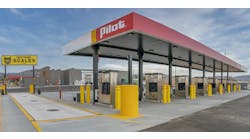Engine oil marketers brace for new era of ‘hyper-efficiency’
The U.S. Environmental Protection Agency and California Air Resources Board (CARB) will have a unified heavy-duty emissions standard beginning in 2027, requiring a 75% reduction in NOx and 50% reduction in PM (particulate matter). An even higher hurdle will be awaiting the industry in 2030.
“These new standards are exerting pressure on engine OEMs to deliver cleaner, more efficient engines, all while making their exhaust aftertreatment systems more effective,” said Walt Collier, commercial sector manager at Chevron, whose products include the Delo line of heavy-duty lubricants.
According to Collier, fleets can expect to begin seeing some new things when they start buying MY2027 heavy-duty trucks that are subject to the new requirements.
“These trucks will include a cylinder deactivation to help maintain higher temperatures within the aftertreatment system to improve NOx conversion efficiency,” Collier said. Other modifications will include closed-coupled, multi-stream, dual-aftertreatment systems consisting of two SCRs and potentially heated DEF dosers.
As was the case with previous changes to emissions standards, the 2027 requirements are creating implications for engine lubricants.
“We are already working to address several key aspects in the next category upgrade of heavy-duty engine lubricants,” said Mary Galic, technology development manager at Lubrizol, a specialty chemicals company whose additives are used by a variety of OEMs and aftermarket marketers. Galic is referring to PC-12 (proposed category) oils that are slated to also hit the marketplace in 2027.
Galic points to the need for improved oxidative stability due to anticipated increases in engine operating temperatures. Wear protection is another focal point.
“We also expect there to be a need for enhanced engine protection of valvetrain components,” Galic pointed out. “We also see an ongoing push for optimized soot-handling capability. We don’t necessarily anticipate seeing higher soot levels in the field with new engines and aftertreatment systems. But we do want to be able to properly protect older engines by making sure there is backwards-compatibility as we continue formulating for PC-12.”
That is precisely why PC-12 oils will be offered in two versions. “PC-12a is more about backwards-compatibility, while PC-12b is more about increasing fuel economy on new vehicles,” Galic explained.
Some in the industry have already begun calling these new oils CL-4 and FB-4, although the API (American Petroleum Institute) hasn’t made anything official yet. Regardless, the trend toward thinner oils is intensifying the need for enhanced wear protection and durability.
“FA-4 has already allowed us to unlock the fuel economy advantage of lower-viscosity engine oils,” Collier said. “Now the engine manufacturers have asked us to go even further. We may see viscosity grades of OW-20 and 5W-20 in heavy-duty applications. This would be a first for the U.S. truck market, though they’ve already started to become prevalent in modern engines in Europe.”
The development of PC-12 oils is still underway. If all goes according to plan, Collier said fleets will start seeing this next generation of heavy-duty lubricants licensed and available in December 2026, in time for the 2027 model year.
In the meantime, fleets should continue working closely with their OEs and engine oil suppliers to make good decisions on what to use right now. It’s important to fully understand the recommended oil drain intervals and engine oil options based on vehicle and application.
“With the new hardware changes and emissions requirements coming, it’s also important to stay engaged,” said Greg Matheson, Lubrizol’s commercial lubricants product manager. “Fleet maintenance managers should learn as much as they can about these new oils being developed for 2027 and where they can fit into the fleet. The sooner a fleet can get out ahead of these changes, the better they can incorporate these new oils when they become available.”




